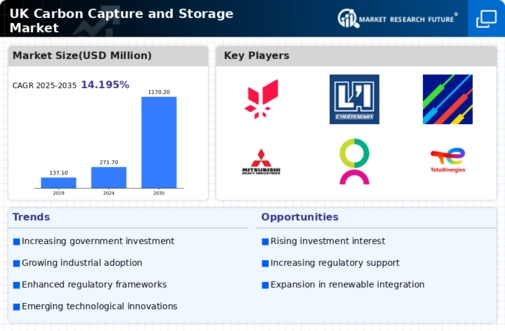Corporate Sustainability Goals
Many corporations in the UK are setting ambitious sustainability goals, which significantly impacts the carbon capture-storage market. A growing number of companies are pledging to achieve net-zero emissions by 2030 or 2040, necessitating the implementation of effective carbon management strategies. This trend is particularly evident in industries such as energy, manufacturing, and transportation, where carbon emissions are substantial. As of 2025, it is estimated that over 50% of major UK corporations have integrated carbon capture technologies into their sustainability frameworks. This shift not only reflects a commitment to environmental stewardship but also positions these companies competitively in a market increasingly driven by sustainability. Consequently, the carbon capture-storage market is likely to benefit from this corporate shift towards greener practices.
Growing Environmental Awareness
The increasing environmental awareness among the UK populace appears to be a pivotal driver for the carbon capture-storage market. As climate change concerns escalate, public demand for sustainable practices intensifies. This heightened awareness has led to a surge in support for policies aimed at reducing carbon emissions. According to recent surveys, approximately 75% of UK citizens advocate for stronger governmental action on climate change, which indirectly bolsters the carbon capture-storage market. Companies are now more inclined to invest in carbon capture technologies to align with consumer expectations and enhance their corporate social responsibility profiles. This trend suggests that as environmental consciousness continues to rise, the carbon capture-storage market will likely experience significant growth, driven by both consumer demand and corporate accountability.
Governmental Financial Incentives
The UK government has introduced various financial incentives to stimulate the carbon capture-storage market. These incentives include grants, tax breaks, and subsidies aimed at encouraging businesses to adopt carbon capture technologies. For instance, the UK government allocated £1 billion to support carbon capture projects as part of its commitment to achieving net-zero emissions by 2050. Such financial backing not only reduces the initial investment burden for companies but also enhances the economic viability of carbon capture initiatives. This proactive approach by the government indicates a strong commitment to fostering innovation in the carbon capture-storage market, potentially leading to increased adoption rates and technological advancements in the sector.
International Climate Commitments
The UK's commitment to international climate agreements, such as the Paris Agreement, serves as a significant driver for the carbon capture-storage market. These commitments necessitate substantial reductions in greenhouse gas emissions, prompting the UK to explore various strategies, including carbon capture technologies. The government has pledged to reduce emissions by at least 68% by 2030 compared to 1990 levels, which underscores the urgency for effective carbon management solutions. This international pressure not only influences domestic policy but also encourages investment in the carbon capture-storage market. As the UK strives to meet its climate obligations, the demand for carbon capture solutions is expected to rise, fostering growth and innovation within the sector.
Technological Advancements in Carbon Capture
Technological advancements are playing a crucial role in shaping the carbon capture-storage market in the UK. Innovations in capture technologies, such as direct air capture and bioenergy with carbon capture and storage (BECCS), are enhancing the efficiency and cost-effectiveness of carbon capture processes. Recent developments indicate that new capture methods could reduce costs by up to 30%, making them more accessible for widespread adoption. Furthermore, ongoing research and development efforts are expected to yield even more efficient solutions in the coming years. This continuous evolution of technology suggests that the carbon capture-storage market will likely expand as companies seek to leverage these advancements to meet regulatory requirements and corporate sustainability goals.


















Leave a Comment